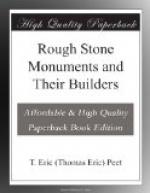CHAPTER II
STONEHENGE AND
OTHER GREAT STONE
MONUMENTS IN ENGLAND AND WALES
Stonehenge, the most famous of our English megalithic monuments, has excited the attention of the historian and the legend-lover since early times. According to some of the medieval historians it was erected by Aurelius Ambrosius to the memory of a number of British chiefs whom Hengist and his Saxons treacherously murdered in A.D. 462. Others add that Ambrosius himself was buried there. Giraldus Cambrensis, who wrote in the twelfth century, mingles these accounts with myth. He says, “There was in Ireland, in ancient times, a pile of stones worthy of admiration called the Giants’ Dance, because giants from the remotest part of Africa brought them to Ireland, and in the plains of Kildare, not far from the castle of Naas, miraculously set them up.... These stones (according to the British history) Aurelius Ambrosius, King of the Britons, procured Merlin by supernatural means to bring from Ireland to Britain.”
From the present ruined state of Stonehenge it is not possible to state with certainty what was the original arrangement, but it is probable that it was approximately as follows (see frontispiece):
[Illustration: FIG. 1. Plan of Stonehenge in 1901. (After Archaeologia.) The dotted stones are of porphyritic diabase.]
There was an outer circle of about thirty worked upright stones of square section (Fig. I). On each pair of these rested a horizontal block, but only five now remain in position. These ‘lintels’ probably formed a continuous architrave (Pl. I). The diameter of this outer circle is about 97-1/2 feet, inner measurement. The stones used are sarsens or blocks of sandstone, such as are to be found lying about in many parts of the district round Stonehenge.
[Illustration: Plate I. STONEHENGE FROM THE SOUTH-WEST
Photo
Graphotone Co. To face p. 17]
Well within this circle stood the five huge trilithons (a-e), arranged in the form of a horseshoe with its open side to the north-east. Each trilithon, as the name implies, consists of three stones, two of which are uprights, the third being laid horizontally across the top. The height of the trilithons varies from 16 to 21-1/2 feet, the lowest being the two that stand at the open end of the horseshoe, and the highest that which is at the apex. Here again all the stones are sarsens and all are carefully worked. On the top end of each upright of the trilithons is an accurately cut tenon which dovetails into two mortices cut one at each end of the lower surface of the horizontal block. Each upright of the outer circle had a double tenon, and the lintels, besides being morticed to take these tenons, were also dovetailed each into its two neighbours.




